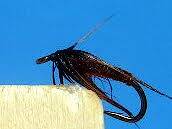
Blue-winged Olives
Baetis
Tiny Baetis mayflies are perhaps the most commonly encountered and imitated by anglers on all American trout streams due to their great abundance, widespread distribution, and trout-friendly emergence habits.
Featured on the forum

It's only barely visible in one of my pictures, but I confirmed under the microscope that this one has a prosternal horn and the antennae are mid-way between the eyes and front of the head capsule.
I'm calling this one Pycnopsyche, but it's a bit perplexing. It seems to key definitively to at least Couplet 8 of the Key to Genera of Limnephilidae Larvae. That narrows it down to three genera, and the case seems wrong for the other two. The case looks right for Pycnopsyche, and it fits one of the key characteristics: "Abdominal sternum II without chloride epithelium and abdominal segment IX with only single seta on each side of dorsal sclerite." However, the characteristic "metanotal sa1 sclerites not fused, although often contiguous" does not seem to fit well. Those sclerites sure look fused to me, although I can make out a thin groove in the touching halves in the anterior half under the microscope. Perhaps this is a regional variation.
The only species of Pycnopsyche documented in Washington state is Pycnopsyche guttifera, and the colors and markings around the head of this specimen seem to match very well a specimen of that species from Massachusetts on Bugguide. So I am placing it in that species for now.
Whatever species this is, I photographed another specimen of seemingly the same species from the same spot a couple months later.
I'm calling this one Pycnopsyche, but it's a bit perplexing. It seems to key definitively to at least Couplet 8 of the Key to Genera of Limnephilidae Larvae. That narrows it down to three genera, and the case seems wrong for the other two. The case looks right for Pycnopsyche, and it fits one of the key characteristics: "Abdominal sternum II without chloride epithelium and abdominal segment IX with only single seta on each side of dorsal sclerite." However, the characteristic "metanotal sa1 sclerites not fused, although often contiguous" does not seem to fit well. Those sclerites sure look fused to me, although I can make out a thin groove in the touching halves in the anterior half under the microscope. Perhaps this is a regional variation.
The only species of Pycnopsyche documented in Washington state is Pycnopsyche guttifera, and the colors and markings around the head of this specimen seem to match very well a specimen of that species from Massachusetts on Bugguide. So I am placing it in that species for now.
Whatever species this is, I photographed another specimen of seemingly the same species from the same spot a couple months later.

Troutnut is a project started in 2003 by salmonid ecologist Jason "Troutnut" Neuswanger to help anglers and
fly tyers unabashedly embrace the entomological side of the sport. Learn more about Troutnut or
support the project for an enhanced experience here.
Creno on Oct 13, 2012October 13th, 2012, 11:47 am EDT
You also may be running into Onocosmoecus unicolor which is much more orange overall. They are also fairly common in CO and occur in larger streams. I am sure that many "orange caddis" fisherperson reports are actually based on O.unicolor. They also look orange/brown in flight.
DUBBN on Oct 13, 2012October 13th, 2012, 12:13 pm EDT
You also may be running into Onocosmoecus unicolor which is much more orange overall. They are also fairly common in CO and occur in larger streams. I am sure that many "orange caddis" fisherperson reports are actually based on O.unicolor. They also look orange/brown in flight.
I will take your word for it. You seem to know where they are, and where they aren't.
It's OK to disagree with me. I can not force you to be right.
Entoman on Oct 13, 2012October 13th, 2012, 5:01 pm EDT
Dubbin -
If it's big, orangish and hatches in the Fall, it's an October Caddis in the West. The truth is very few (if any) of these large limnephilids have universally accepted common names anyway. However, if you are interested in knowing the precise species you have encountered, there are a few things that may help, though collecting one to ship off to a caddis expert like Dave for professional diagnosis is the only way to know for sure in a lot of cases. O. unicolor as its scientific name implies, usually has very little or no contrast in color between wing, body and legs. If you remember whether or not your critters had contrast or noticable markings as in the photos in Paul's link, that might point to one or the other. Another clue is the habitat, as unicolor prefers much slower water and is usually found in pools or stillwaters - not riffles, runs and rock gardens. Though it also hatches earlier, this factor may not help much unless both are present as dates can vary widely from year to year.
Off the cuff, if they have wings noticeably darker than their bodies or are in swift water environs, I'd go with D. atripes. However, if they are a "unicolorous" cinnamon or dark ginger color and hanging around frog water (not the kind I would associate with the Gunnison from the little I know of that river), then I'd go with unicolor or perhaps even another species. Just my take, FWIW.:)
If it's big, orangish and hatches in the Fall, it's an October Caddis in the West. The truth is very few (if any) of these large limnephilids have universally accepted common names anyway. However, if you are interested in knowing the precise species you have encountered, there are a few things that may help, though collecting one to ship off to a caddis expert like Dave for professional diagnosis is the only way to know for sure in a lot of cases. O. unicolor as its scientific name implies, usually has very little or no contrast in color between wing, body and legs. If you remember whether or not your critters had contrast or noticable markings as in the photos in Paul's link, that might point to one or the other. Another clue is the habitat, as unicolor prefers much slower water and is usually found in pools or stillwaters - not riffles, runs and rock gardens. Though it also hatches earlier, this factor may not help much unless both are present as dates can vary widely from year to year.
Off the cuff, if they have wings noticeably darker than their bodies or are in swift water environs, I'd go with D. atripes. However, if they are a "unicolorous" cinnamon or dark ginger color and hanging around frog water (not the kind I would associate with the Gunnison from the little I know of that river), then I'd go with unicolor or perhaps even another species. Just my take, FWIW.:)
"It's not that I find fishing so important, it's just that I find all other endeavors of Man equally unimportant... And not nearly as much fun!" Robert Traver, Anatomy of a Fisherman
Entoman on Oct 15, 2012October 15th, 2012, 12:12 am EDT
Paul,
And in large numbers too! Sorry I missed confirming this statement. Same goes for NorCal also!
Hat Creek (both lower and in the Rising River Valley), McCloud River, and the Upper Sac come to mind. A feeder to one of the afore mentioned has good populations of these bugs with an equally good population of browns ascending for spawning rituals. Good combination...:)
Here's a really nice presentation on a Dicosmoecus from Oregon where apparently they emerge on larger waters:
And in large numbers too! Sorry I missed confirming this statement. Same goes for NorCal also!
Hat Creek (both lower and in the Rising River Valley), McCloud River, and the Upper Sac come to mind. A feeder to one of the afore mentioned has good populations of these bugs with an equally good population of browns ascending for spawning rituals. Good combination...:)
"It's not that I find fishing so important, it's just that I find all other endeavors of Man equally unimportant... And not nearly as much fun!" Robert Traver, Anatomy of a Fisherman
PaulRoberts on Oct 15, 2012October 15th, 2012, 8:12 am EDT
A feeder to one of the afore mentioned has good populations of these bugs with an equally good population of browns ascending for spawning rituals. Good combination...:)
Now that sounds exciting. Will those browns respond to a waked dry?
Entoman on Oct 15, 2012October 15th, 2012, 11:26 am EDT
Strangely enough Paul, not too often. Steelhead aside, most action occurs from a dead drift presentation after a fairly splashy delivery. Sort of like fishing a hopper. Matter of fact, hopper patterns often work quite well. What I've noticed is that trout often ignore the adults and it is rare that I see a big rise of fish for them. Most of the time it seems the best dry fly action occurs when they are relatively sparse and the fish take their imitations opportunistically.
Fishing their hatches is very much like fishing the big Salmonfly hatches. Both big bugs with very similar behavior. Neither emerge by drifting during daylight hours (like the great Baetis activity that's just around the corner) and the adults are only available when they come back to lay eggs or get a drink. Thinking back over the years, I've had similar experiences with both in that nymphing is usually the most successful approach on larger waters with some depth. I think the reason is because their populations are dense enough that there's always some in the drift and trout are always on the lookout for such big packages of protein. On the other hand, small creeks almost always fish better dry.
Sometimes the fishing is very slow when these critters are super abundant. I have no evidence beyond anecdotal but my suspicion is that this is often due to the fish being sated. It doesn't take many of these bugs to fill them up.:)
Fishing their hatches is very much like fishing the big Salmonfly hatches. Both big bugs with very similar behavior. Neither emerge by drifting during daylight hours (like the great Baetis activity that's just around the corner) and the adults are only available when they come back to lay eggs or get a drink. Thinking back over the years, I've had similar experiences with both in that nymphing is usually the most successful approach on larger waters with some depth. I think the reason is because their populations are dense enough that there's always some in the drift and trout are always on the lookout for such big packages of protein. On the other hand, small creeks almost always fish better dry.
Sometimes the fishing is very slow when these critters are super abundant. I have no evidence beyond anecdotal but my suspicion is that this is often due to the fish being sated. It doesn't take many of these bugs to fill them up.:)
"It's not that I find fishing so important, it's just that I find all other endeavors of Man equally unimportant... And not nearly as much fun!" Robert Traver, Anatomy of a Fisherman
Quick Reply
Related Discussions
Topic
Replies
Last Reply
Re: You Western anglers - any experience with the Giant Orange Sedges?
In the Caddisfly Genus Dicosmoecus by Troutnut
In the Caddisfly Genus Dicosmoecus by Troutnut
7
Jan 7, 2009
by Dgracia
by Dgracia
14
Sep 26, 2013
by Crepuscular
by Crepuscular
19
Oct 24, 2008
by Jack_k
by Jack_k
2
Sep 20, 2020
by Creno
by Creno
Re: Identification of a possible Cordulegaster Dragonfly Nymph
In Cordulegaster Dragonfly Nymph by IanB
In Cordulegaster Dragonfly Nymph by IanB
6
Feb 10, 2017
by Taxon
by Taxon




